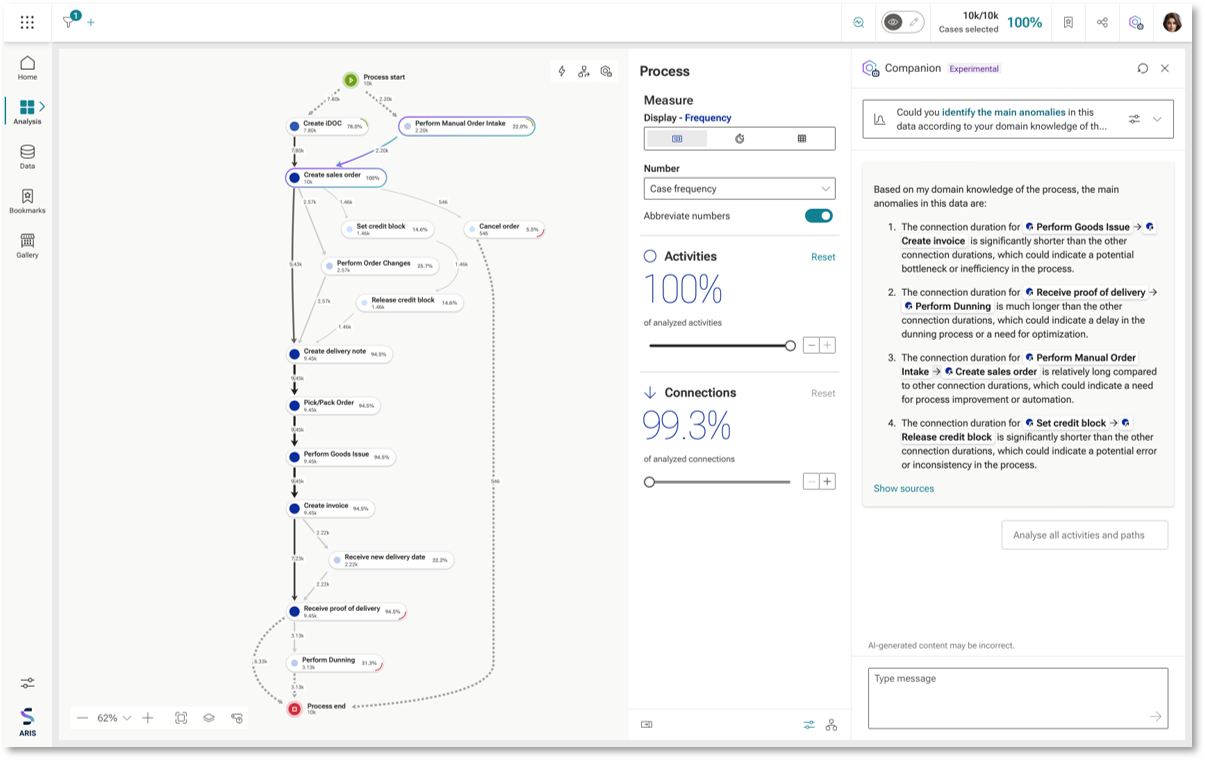Die Integration von Künstlicher Intelligenz (KI) in das Prozessmanagement ist kein Zukunftsthema mehr – sie ist gelebte Gegenwart. Ob Prozessdokumentation, Analyse oder Process Mining: KI verändert, wie Unternehmen zukünftig ihre Prozesse gestalten, steuern und verbessern. Insbesondere Tools wie ARIS mit integriertem AI Companion zeigen eindrucksvoll, wie KI heute schon reale Mehrwerte liefert – über alle Phasen des Prozessmanagements hinweg.
Wie kann KI im Prozessmanagement unterstützen?
Viele Unternehmen – besonders im Mittelstand – sehen sich derzeit mit einer Vielzahl an Herausforderungen konfrontiert. Ständig wachsende Compliance-Anforderungen und sich verändernde wirtschaftspolitische Rahmenbedingungen erfordern ein grundsätzlich neues Denken hinsichtlich der Marktpositionierung, eine Anpassung der Organisation sowie eine Neuausrichtung der gesamten Supply Chain. Im Kern bedeutet dies, Veränderungen proaktiv anzustoßen, Prozesse fokussiert und zügig neu aufzusetzen und diese anschließend effizient zu steuern. Vor diesem Hintergrund ist es nicht verwunderlich, dass der Ruf nach Technologien laut wird, die schnelle und messbare Erfolge ermöglichen. Entsprechend hoch sind die Erwartungen an KI-basierte Lösungen – sie sollen beispielsweise
Kundenerlebnisse verbessern – durch smarte Marktanalysen
Kosten reduzieren – durch Unterstützung fundierter Entscheidungen
Produktivität steigern – durch Automatisierung von Routineaufgaben
Risiken frühzeitig erkennen – durch KI-gestützte Auswertung von Unregelmäßigkeiten
Viele Softwarehersteller integrieren inzwischen eigene KI-Funktionen direkt in ihre Anwendungen. Darüber hinaus stehen auch externe KI-Tools wie ChatGPT, Copilot oder der ARIS AI Companion zur Verfügung – intuitiv bedienbar und schnell einsetzbar.
In der Vielfalt an verfügbaren Lösungen ist jedoch eines entscheidend: Erst das Zusammenspiel von Technologie, fachlicher Expertise und klarer Governance ermöglicht einen wirklich sinnvollen und nachhaltigen Einsatz von KI.
Von der Idee zur Umsetzung: So gelingt der Einstieg
Relevante Use Cases identifizieren und priorisieren
Ermitteln Sie gezielt Anwendungsfälle, in denen KI echten Mehrwert liefern kann – etwa:
Kundenzentrierung durch personalisiertes Marketing,
Effizienzsteigerung im Service durch intelligente Chatbots,
Risikominimierung durch automatisierte Erkennung von Prozessabweichungen (z. B. im Compliance-Bereich).
Wichtig ist, Use Cases auszuwählen, die sowohl geschäftlich relevant als auch technisch machbar sind und dabei erste Erfolge sichtbar machen.
Mit Pilotprojekten starten – „Think big, start small“
Beginnen Sie mit klar abgegrenzten Pilotprojekten, um Erfahrungen im Umgang mit KI-Technologien, Tools wie dem ARIS AI Companion und neuen Arbeitsweisen zu sammeln.Stellen Sie sicher, dass Projektmitarbeitende ausreichend Kapazität haben – KI-Piloten sollten nicht „nebenbei“ laufen.
Fördern Sie die interdisziplinäre Zusammenarbeit zwischen Fachbereichen, IT und Data/AI-Teams von Anfang an.
Datenverfügbarkeit und Governance klären
Ohne verlässliche Daten kein wirksamer KI-Einsatz. Klären Sie daher frühzeitig:Welche Daten liegen vor?
Wo sind diese verfügbar (z. B. im Prozessportal, ERP, CRM)?
Wer trägt die Verantwortung für Datenqualität und -zugang?
Unterstützt Ihre Prozessdokumentation bereits strukturierte, maschinenlesbare Informationen?
Eine klare Governance ist essenziell – auch um Risiken beim KI-Einsatz (Bias, Blackbox-Verhalten) frühzeitig zu adressieren.
Erkenntnisse skalieren & automatisieren
Nutzen Sie Erkenntnisse aus Pilotprojekten, um ähnliche Prozesse im Unternehmen zu optimieren.Setzen Sie gezielt KI-Agents ein, um repetitive Tätigkeiten zu automatisieren.
Integrieren Sie KI in den gesamten Prozesslebenszyklus – von Modellierung über Simulation bis zur kontinuierlichen Verbesserung.
Prompt-Kompetenz & Toolnutzung fördern
Schulen Sie Mitarbeitende gezielt im Umgang mit KI-Tools und Prompt-Engineering:Wie formuliere ich effektive Prompts für Prozessmodellierung oder Analyse mit dem ARIS AI Companion?
Wie lässt sich die eigene Toolkompetenz kontinuierlich verbessern?
Nur durch gezielte Qualifizierung kann KI ihre Wirkung im Arbeitsalltag entfalten – und wird zum echten Assistenzsystem für Prozessverantwortliche.
ARIS & KI – mehr als nur Modellierung
Im Bereich des Prozessmanagements setzt ARIS mit seinen KI-gestützten Funktionen neue Maßstäbe. Durch die Integration des AI Companion wird es möglich, per natürlicher Sprache Prozesse zu modellieren, automatisiert zu analysieren und Optimierungspotenziale aufzudecken – direkt innerhalb der zentralen Prozessmanagementplattform. Damit unterstützt ARIS nicht nur die Effizienzsteigerung in der Prozessdokumentation, sondern fördert auch datenbasierte Entscheidungen und eine neue Qualität der Zusammenarbeit zwischen Fachbereichen und IT. Die KI wird so zum aktiven Sparringspartner im gesamten Lebenszyklus des Prozessmanagements – von der Ideengenerierung bis hin zur kontinuierlichen Verbesserung.
🧠 Beispielhafte KI-Funktionen in ARIS:
Prompt-Tipps aus der Praxis
„Generiere ein Modell für den Warenausgang mit folgenden Schritten: Auftrag prüfen → Ware kommissionieren → Lieferschein erstellen → Versand.“
→ ARIS Companion erstellt ein BPMN-Modell mit Aufgaben, Rollen und Systemen.
„Zeige mir alle Prozesse mit Durchlaufzeiten über 7 Tage.“
→ Process-Mining-Auswertung mit KI-gestützter Priorisierung von Bottlenecks.
„Welche KPIs sind für den Genehmigungsprozess definiert?“
→ Automatische Auslesung und Verlinkung zu KPI-Glossareinträgen.
Beispiel Prompt: Suche nach speziellen Informationen in der ARIS Datenbank mit natürlicher Sprache
KI Mehrwert im Process Mining – der versteckte Gamechanger
Künstliche Intelligenz liefert nicht nur bei der Prozessmodellierung einen Mehrwert – auch im Process Mining entfaltet sie enormes Potenzial, um Prozesse effizienter, robuster und transparenter zu gestalten:
Automatische Identifikation von Prozessvarianten
Erkennen Sie auf Knopfdruck, welche Varianten vom definierten Soll-Prozess abweichen – inklusive Häufigkeit und Auswirkungen.
Anomalie-Erkennung in Echtzeit
Beispielsweise bei fehlenden Freigaben, Umgehungen oder Compliance-Verstößen – bevor diese zu echten Problemen werden. ARIS Process Mining kann hier gemeinsam mit ARIS Compliance Manager ein direkter Weg zur Umsetzung von Compliance Richtlinien sein, da erkannte Anomalien umgehend als issues angelegt und zur Prüfung angetriggert werden.
Optimierungsvorschläge auf Basis historischer Daten
KI erkennt Muster, bewertet Potenziale und schlägt gezielt Verbesserungsmaßnahmen vor – datengestützt und objektiv.
KI-gestütztes Clustering von End-to-End-Prozesspfaden
Komplexe Abläufe werden strukturiert visualisiert und in verständliche Gruppen überführt – ideal zur Ursachenanalyse und Kommunikation mit Fachbereichen.
Beispiel: Erkennung von Anomalien im IST Prozess
Fazit: KI als Transformationsmotor im Prozessmanagement
Künstliche Intelligenz ersetzt kein Fachwissen – sie verstärkt und ergänzt es. Besonders im Zusammenspiel mit leistungsfähigen Plattformen wie ARIS entfaltet KI ihre volle Wirkung entlang des gesamten Prozessmanagement-Zyklus:
Von der strukturierten Datenerhebung,
über intelligente Analyse und automatisierte Modellierung,
bis hin zur kontinuierlichen Verbesserung und Steuerung komplexer Prozesslandschaften.
Erfolgsfaktoren:
Fokus auf relevante Prozesse mit klarem Geschäftsnutzen
Definierte Rollen & Governance-Strukturen für sichere Anwendung
Schulung & Change-Kommunikation, um Akzeptanz zu schaffen
Vertrauen in datengetriebene Entscheidungen, auch bei Unsicherheit
Ausblick
Die Zukunft des Prozessmanagements ist geprägt von der Kombination aus:
Agentic AI – autonome KI-Systeme, die Prozesse nicht nur analysieren, sondern proaktiv steuern.
Process Intelligence – tiefere Einsichten durch nahtlose Integration von Daten, Prozessen und Kontextwissen.
Business Empowerment – Fachbereiche werden zu aktiven Mitgestaltern datengetriebener Prozesse.
Doch bei aller technologischen Dynamik gilt auch:
Stabilität:
Prozesse brauchen Struktur und Klarheit – auch KI basiert auf gut dokumentierten Abläufen.
Fachliche Expertise bleibt unverzichtbar – KI ist ein Verstärker, kein Ersatz.
Governance, Verantwortlichkeiten und Transparenz behalten zentrale Bedeutung.
Veränderung:
Modellierung, Analyse und Optimierung werden interaktiv und KI-gestützt.
Fachbereiche agieren datengetriebener und autonomer – ohne auf die IT zu warten.
Prozesse sind nicht mehr statisch, sondern lernen und passen sich kontinuierlich an.
ARIS mit dem AI Companion steht an der Schnittstelle dieser Transformation. Die Plattform bleibt vertraut in Struktur und Governance – wird aber durch KI zu einem intelligenten Co-Piloten im täglichen Prozessmanagement. Die Zukunft beginnt jetzt – und sie bringt mehr Chancen als Risiken.








